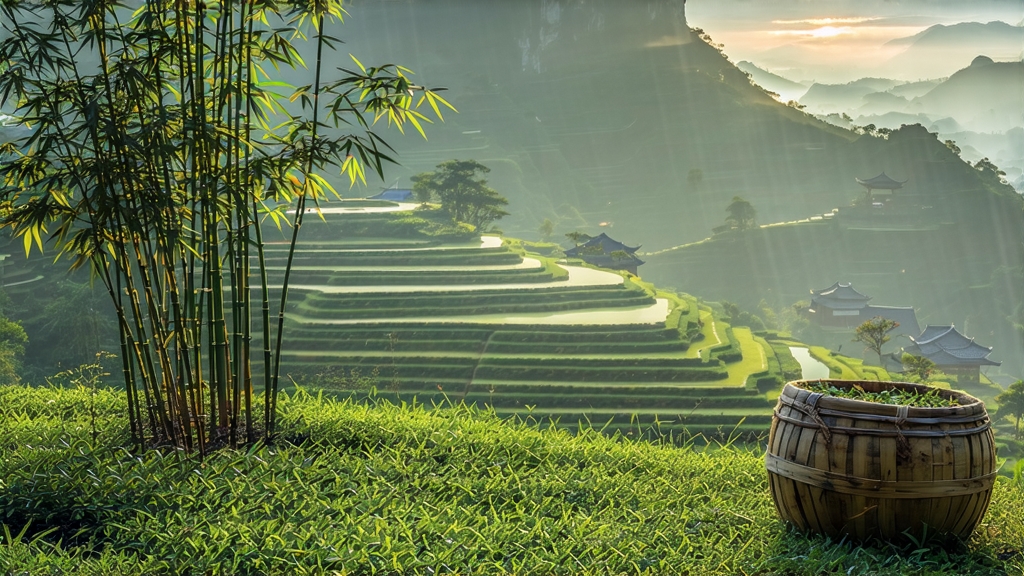
Tucked high on the mist-laden peaks of Mt. Meng in Sichuan province, Meng Ding Huang Ya has been whispered about in Chinese tea circles for more than twelve centuries. Foreign drinkers often meet yellow tea through the famous Hunan Junshan Yin Zhen, yet Meng Ding Huang Ya—older, subtler, and once reserved for emperors—remains an unsung ambassador of the yellow tea family. This essay invites the global tea lover to discover its origin myths, micro-climate, hand-crafted yellowing process, and the quiet ritual that coaxes its orchid-and-chestnut soul into a cup.
-
A leaf born among clouds
Mt. Meng, “the Rainy Peak,” rises 1 450 m where the Sichuan basin collides with the Tibetan plateau. Warm, moisture-laden clouds roll up the cliff faces each afternoon, cooling abruptly at dusk and bathing the tea gardens in a perpetual veil. The soil is a loose, volcanic sandy loam rich in quartz and humus; drainage is instant, yet water is ever-present as mist. Such conditions force the tea bush to grow slowly, thickening the cell walls and concentrating amino acids. The local cultivar, a Camellia sinensis var. sinensis landrace known to villagers as “xiao ye zhong” (small-leaf type), produces a bud so tight and downy that pickers call it “golden sparrow tongue.” -
From Buddhist offering to Tang dynasty tribute
The first written record appears in 724 CE when a monk from the nearby Yongxing Temple presented “meng ding sweet dew” to Emperor Xuanzong. By Song times the tea had already shifted colour: poets describe a “three-yellow” leaf—yellow bud, yellow liquor, yellow leaf bottom—evidence that the yellowing technique was mature. Ming dynasty taxation lists quantify the burden: 400 jin (240 kg) of the finest buds had to reach Beijing within twenty days of Qingming festival, carried by relay runners across 1 800 km of mountain post roads. Those imperial lots were sealed with cinnabar wax and labelled “Huang Ya,” literally “yellow bud,” giving the tea its modern name. -
The six-hour breath that turns green to gold
Unlike green tea whose kill-green aims to fix freshness, Meng Ding Huang Ya is allowed to breathe. The craft, passed father to son in the village of Shangqing, unfolds in five stages:
a) Pluck: only the unopened bud and the half-open first leaf, before sunrise on days when the mountain mist is thickest. Moisture on the leaf prevents mechanical bruising.
b) Sha Qing (initial kill-green): 30 seconds at 140 °C on a cast-iron pan, just enough to rupture oxidative enzymes on the surface while keeping the inner cell alive.
c) Re-moistening: the half-dry leaves are piled in bamboo trays and covered with white cotton for 40 minutes; residual heat and humidity re-awaken endogenous enzymes.
d) Men Huang (sealed yellowing): the critical signature step. The trays are slid into a pine-wood cabinet lined with wet goat-skin. Temperature 32 °C, RH 78 %. Every 20 minutes the pile is gently turned; oxidation proceeds slowly, turning chlorophyll into pheophytin and releasing a cascade of floral volatiles. After six hours the leaf colour shifts from jade to old gold.
e) Low-temperature baking: charcoal embers at 60 °C for two hours reduce moisture to 5 % while caramelising free sugars, imprinting the nutty note that connoisseurs compare to roasted chestnut.
- Grades and micro-lots
Villagers recognise three grades judged solely by bud size and down density:
• Imperial Sparrow Tongue: 15 mm bud, 70 % down coverage, liquor the colour of chardonnay with a ring of jade-green light.
• Noble Needle: 18 mm, 50 % down, deeper yellow liquor, longer chestnut finish.
• Fragrant Down: 22 mm, 30 % down, still elegant but designed for everyday drinking; price one-third of Imperial.
Modern exporters sometimes add “pre-Qingming” or “grain-rain” tags, yet locals insist the mountain micro-climate matters more than solar calendar; buds plucked during persistent fog can outperform earlier harvests from lower elevations.
- Brewing the imperial way